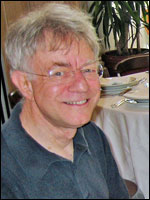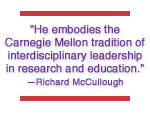|
|
|||||
|
|
Carnegie Mellon Holds Conference on Applied Analysis To Celebrate 65th Birthday of Mathematician David Kinderlehrer
A professor of mathematical sciences, Kinderlehrer is widely acclaimed for his central role in pushing the frontiers of applied analysis, specifically the role of applied analysis in materials science applications.
"David has used mathematics to help explain phenomena such as grain growth in polycrystals, and he has drawn inspiration from physical phenomena to develop new theoretical mathematical tools. He embodies the Carnegie Mellon tradition of interdisciplinary leadership in research and education," said Richard D. McCullough, dean of the Mellon College of Science and professor of chemistry.
"David was one of the first to realize the impact that mathematics could have in materials science. He was a leading force in changing completely the landscape of mathematical analysis in materials science," said Irene Fonseca, Mellon College of Science Professor of Mathematics and director of the university's Center for Nonlinear Analysis.
The conference brings together an impressive group of preeminent mathematicians whose innovative work places them at the leading edge of the field of applied analysis, according to the organizers. Presenters from the University of Minnesota, New York University's Courant Institute of Mathematical Sciences, the University of Bonn and other institutions are speaking about their research in applied mathematics and how it supports new developments in the field of materials science.
Kinderlehrer's research has made a profound impact on applied analysis. In the early 1970s he advanced the study of free boundary problems. He then tackled issues on multi-scale problems dealing with microstructures, liquid and solid crystals. Recently, he has made tremendous contributions to analyzing images of material grains and deriving a statistic that tells what this total grain boundary energy is. He is working toward using these total energies measured from material footprints to simulate and carefully design materials of the future so that these materials closely fit specific performance criteria.
"David is a builder of bridges across areas and disciplines, which is evidenced by his participation in the Materials Research Science and Engineering Center (MRSEC)," said Fonseca.
The MRSEC at Carnegie Mellon, which is funded by the National Science Foundation, is an interdisciplinary research and educational enterprise dedicated to the understanding, control and optimization of grain boundary dominated materials properties. Carnegie Mellon is the only NSF-funded MRSEC to have mathematicians as part of the MRSEC faculty.
Kinderlehrer received his bachelor's of science in mathematics from the Massachusetts Institute of Technology and his doctorate in mathematics from the University of California, Berkley. He has been the organizer, co-organizer or member of committees for scientific meetings and symposia, and is on the editorial board of numerous top journals in the field.
Sponsors of the Conference on Applied Analysis include the Department of Mathematics and the National Science Foundation.
For more information, visit http://www.math.cmu.edu/cna/kinderlehrer/index.html.
Amy Pavlak |
|||
|
Carnegie Mellon Home |
|||||

 In 1991, Kinderlehrer co-founded the Center for Nonlinear Analysis (CNA), Carnegie Mellon's flagship applied math center. He was director of the CNA from 1994-1998 and is currently the center's co-principal investigator. Through his work at the CNA, Kinderlehrer has forged dynamic, multidisciplinary initiatives between applied mathematicians and allied scientists, according to Fonseca, and he has helped to train a wealth of postdocs who are now distinguished leaders in their own right.
In 1991, Kinderlehrer co-founded the Center for Nonlinear Analysis (CNA), Carnegie Mellon's flagship applied math center. He was director of the CNA from 1994-1998 and is currently the center's co-principal investigator. Through his work at the CNA, Kinderlehrer has forged dynamic, multidisciplinary initiatives between applied mathematicians and allied scientists, according to Fonseca, and he has helped to train a wealth of postdocs who are now distinguished leaders in their own right.